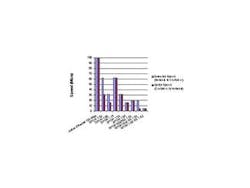The FTTP battlefield: Active Ethernet vs. PON
By BARRY KANTNER
World Wide Packets
The broadband access market is heating up. Recent months have witnessed several new companies introducing active Ethernet products while passive optical networking (PON) vendors continue to make noise about their solution to the last mile bottleneck. Providers - from the largest national carriers to the smallest local telcos - are actively evaluating these two broadband access solutions to determine the benefits of each technology. But beyond all the hype, what are the real technical differences between the various PON flavors and active Ethernet?
A short history of PON
The rationale of using a passive optical infrastructure to deliver broadband services made clear sense in the mid 1980s when PON solutions were first introduced. Since prices for fiber-optic cable and optical transceivers were exorbitant, sharing those resources was the only practical way to deploy optical services cost-effectively. Today, the cost of fiber-optic cable and optical transceivers is a fraction of what they were, and great advances have been made to reduce the cost of installing, splicing, and terminating fiber. These cost reductions combined with the reach, scalability, and revenue generation potential of a switched, point-to-point optical solution make selecting standards-based Ethernet a very attractive option for PON.
The basic premise of all PON architectures is to share the optical feeder and a port on the central distribution unit known as the optical line terminal (OLT) among as many subscriber terminals, or optical network units (ONUs) as possible. Passive optical splitters terminate the optical feeder and provide optical connections to the ONU. This portion of a deployment is referred to as the optical distribution network (ODN). PON was created to allow the cost of the deployment to be shared between all subscribers the OLT can support. While this may have been desirable when the cost of the access infrastructure was very high, the tradeoffs and restrictions of a shared access infrastructure are not necessary today.
PON varieties
There are several variations of PON available today including standard and proprietary versions, none of which fully interoperate between themselves or support easy migration from one to the other without stranding significant capital investments.
The first and most widely deployed PON architecture is ATM PON (APON), also referred to as broadband PON (BPON). Created in the mid-1980s and standardized in the mid-1990s as ITU-T G.983, it utilizes ATM as the transport protocol and operates at speeds of either 155 Mbits/sec or 622 Mbits/sec. Increasing the speed of a subscriber terminal from 155 Mbits/sec to 622 Mbits/sec requires deployment of an entirely new OLT, passive splitters, and ONUs. Up to 32 ONUs share a single OLT port and results in bandwidth per subscriber of 4.8 Mbits/sec for 155-Mbit/sec systems, and 19.4 Mbits/sec for 622-Mbit/sec systems.
Recognizing the bandwidth per user limitations of APON/BPON, a new PON architecture loosely based on Ethernet emerged. Recently standardized as part of IEEE 802.3ah, Ethernet PON (EPON) was created by adding extensions to IEEE 802.3 that enable point-to-mulitpoint operation over point-to-point physical connections. While EPON OLT and ONU equipment may have standards-based Ethernet interfaces for connection to equipment outside the ODN, the connection between the OLT and ONU are not compatible with equipment compliant with the Ethernet 802.3ah standard, and therefore do not support interoperability with the large, low-cost deployed base of Ethernet equipment. EPON shares 1 Gbit/sec of bandwidth at the OLT port with up to 32 ONUs resulting in 31.25 Mbits/sec of bandwidth per subscriber.
The bandwidth limitations of APON/BPON and EPON spurred the development of yet another variation of PON called Gigabit PON (GPON). GPON achieved standardization in 2003 as ITU-T G.984.1, G.984.2, and G.984.3. GPON defines a completely new protocol designed to support multiple services in their native formats. Operating at 2 Gbits/sec or 1 Gbit/sec (network to subscriber) and 155 Mbits/sec, 622 Mbits/sec, 1 Gbit/sec, or 2 Gbits/sec (subscriber to network), up to 64 ONUs can share a single OLT port. GPON provides significantly more flexibility than APON/BPON or EPON and can support twice the number of subscribers per OLT while providing 31.25 Mbits/sec of bandwidth to each subscriber. Alternatively, GPON can be deployed with only 32 subscribers sharing an OLT port resulting in 62.5 Mbits/sec per subscriber, but at an elevated higher cost.
There are a number of other PON variations and hybrid implementations that are not based on any existing current or planned standards. Vendors of these solutions have created them in an attempt to solve one or many of the problems and limitations of a shared network infrastructure.
Active Ethernet uses IEEE 802.3 standard, active components to extend Ethernet to the subscriber in a switched topology offering a fully symmetrical 100 Mbits/sec or 1 Gbit/sec of bandwidth to every subscriber. If additional bandwidth is required, 10-Gbit/sec standard based Ethernet solutions are available and efforts are underway to standardize 40 and 100-Gbit/sec speeds. Using IEEE 802.3 standard components results in very low cost solutions due to the millions of ports of already-deployed Ethernet connections worldwide, and allows full interoperability with other standards-based solutions from a number of vendors.
Reach
Two factors impact the reach of a PON deployment. The first is the total available optical power budget, which is a factor of the OLT laser port and the total loss budget, including the fiber feeder and splitters. The second is the risk of simultaneous transmission between the ONUs. Because ONUs share the optical feeder and OLT port, a sophisticated algorithm is required within all the devices to prevent more than one ONU from transmitting at the same time. If a simultaneous transmission occurs, the resulting traffic collisions would render most applications unusable. The algorithm measures and accommodates for the differences in distances between the ONUs and the OLT. Delay increases with distance. As the delay increases, the window for an ONU to transmit to the OLT decreases. This directly affects the amount of useable bandwidth, or throughput, which is available to the ONU. The algorithm limits the maximum distance between all ONUs and the OLT in order to maintain acceptable ONU throughput performance. PON standards provide for a maximum distance of 20 km between the OLT and ONU, while most vendors recommend a maximum distance of 10 km.
Figure 1 shows the serving areas for both a PON and active Ethernet deployment. The PON diagram illustrates the attention to detail that must be taken when selecting deployment locations for PON splitters while taking into account the maximum distance allowed between the OLT and ONU. The yellow circle represents the maximum distance an ONU can be located from the OLT (20 km in this example). The green circles represent the location of the splitters and the maximum distance the ONU can be located from the splitter. The distance from the OLT to the splitters determines the maximum distance between the ONU and the splitters. In all cases the maximum distance between the OLT and the ONU cannot exceed the system specifications. Figure 1 offers two examples: one that locates the splitters 19 km from the OLT and results in a serving area radius of 1 km, and one that locates the splitters 10 km from the OLT and results in a serving area radius of 10 km. In both cases, each serving area supports a maximum of 32 ONUs.
This results in a complex set of tradeoffs and compromises that require constant evaluation:
• If less than 32 subscribers are located within the ONU serving radius, the OLT cost per subscriber served is very high.
• If more than 32 subscribers are located within an ONU serving radius, a second OLT port must be deployed to support the 33rd subscriber and results in a steep spike in the OLT cost per subscriber served.
• If one customer requires service outside of an existing ONU serving radius, a new OLT port must be deployed to support the customer and results in the OLT cost per subscriber served being very high.
• If customers outside the 20-km OLT serving area require service, a complete OLT chassis must be deployed in a new physical location that can reach the customer, and results in the OLT cost per subscriber served being very high.
Active Ethernet platforms can be located up to 120 km from each other without any geographic restrictions, or variations in the platforms. As shown in Figure 1, this enables the solution to address a very large serving area without the need to preplan deployments, or risk stranded capital investments. These platforms can be deployed and interconnected, or linked to other standards-based Ethernet platforms, in any combination. This enables any customer located within the serving area to be provided services without consideration of geographic reach.
Most active Ethernet platforms rely on standards-based small form factor pluggable (SFP) optical transceivers. A wide variety of SFP optical transceivers are available from a number of suppliers, enabling the best match between deployment requirement and cost. SFP optical transceivers are available that support:
• 100 Mbits/sec and 1,000 Mbits/sec,
• Multimode and singlemode,
• Operating distances from 850 m to 120 km, and
• Operating wavelengths from 850 to 1610 nm.
Deployment costs and predictability
By their nature, OLT ports are expensive because they are designed to push a broadband optical signal up to 20 or 30 km with enough power to light up 32 or more ONUs. The cost of an OLT port doesn't start to become economical until the OLT is serving approximately 26 ONUs, or approximately 81% of the total supported ONUs. Cost of a PON deployment can widely fluctuate because of the high price of the OLT, the large number of ONUs that are required to make the OLT deployment economical, and the limited geographic coverage of the ONU serving area.
At first, the cost to deploy the first PON subscribers spikes, mainly due to the fact that the OLT is expensive. The cost per subscriber for PON falls rapidly as the number of ONUs sharing an OLT increases. However, once the maximum number of ONUs an OLT supports is reached, a new investment in an OLT is required, and the cost per subscriber goes up dramatically. Active Ethernet cost predictions for the first subscribers are much lower than the first subscriber cost for PON. It also has a much narrower range as subscribers are added. Active Ethernet thus provides a linear and predictable cost of customer acquisition from the first few subscribers to many thousands of subscribers.
The cost per subscriber for PON is also greatly influenced by the location of the splitters in relation to the OLT. The further away the splitters are located from the OLT, the smaller the ONU serving radius becomes. This results in the best utilization of the fiber feeder plant, but requires a high density of potential customers in the ONU serving area in order to achieve the number of served customers necessary to make the OLT deployment economical. The nearer the splitters are located to the OLT, the larger the ONU serving radius becomes. For areas where potential customer density is lower, a larger ONU serving radius is able to address more potential customers. However, this results in the least efficient utilization of the fiber feeder plant.
The geographic limitations of PON make it difficult to achieve the necessary number of ONUs for a cost-effective OLT deployment. Pre-planning the exact location of the splitters in relation to the OLT in order to maximize the number of subscribers per OLT is challenging. Many factors influence subscriber behavior and take-rates for services.
Because of these geographical limitations, PON deployments result in unpredictable customer acquisition costs that can yield significant amounts of stranded capital waiting for ONU serving areas to reach the optimum number of subscribers.
Capital expenses for active Ethernet are coincident with subscriber acquisition. This means deployed capital is immediately put to work generating revenue. And because subscribers can be added up to 120 km from the distribution or concentration site without any geographic restrictions, active Ethernet helps reduce the need for pre-planning deployments.
Bandwidth per subscriber and revenue generation potential
Because all subscriber terminals share the OLT and the optical feeder, the available bandwidth per subscriber terminal is also shared. The total amount and range of bandwidth available to share depends on the specific type of PON technology and the split ratio deployed. Active Ethernet solutions support fully symmetrical 100-Mbit/sec connections to each subscriber, far in excess of even the fastest PON implementations (see Figure 2). The same active Ethernet system can also support fully symmetrical 1 Gbit/sec, or even 10-Gbit/sec subscriber connections. Only standard-based Ethernet solutions are capable of this scalability and are able to leverage the low cost of Ethernet components.
The additional bandwidth and significantly expanded coverage area of the active Ethernet systems, combined with the linear cost of customer acquisition, make selecting this technology over PON simple. While PON technologies can be deployed with lower split ratios resulting in more available bandwidth per subscriber, this effectively increases the cost-basis of the solution. For example, decreasing the split ratio of EPON from 1:32 to 1:16 increases the available bandwidth per subscriber to just over 60 Mbits/sec, but more than doubles the cost-basis of the solution since the OLT port is now shared among fewer ONUs.
Operating expense
PON vendors assert that using passive splitters instead of active elements between the OLT and ONU, will realize cost savings for the network operator by eliminating the need to power and service active components, thus lowering the overall maintenance costs since fewer powered elements will require service. But it is important to note that the OLTs and ONUs, which are located in the field at the customer premise, are actually active components.
Even in the worst case active Ethernet deployment, the total number of concentrator sites that contain active, powered components is just over 1% of the total number of sites. The significant benefits of a deployment far outweigh the additional maintenance costs due to active components in the field versus a similar passive deployment.
Passive deployments have only one path between the OLT and the ONU. If an OLT fails, or the fiber feeder between the OLT and the passive splitter is cut, all of the ONUs will be out of service. In addition to having mean time between failure ratings measured in years, active Ethernet systems can be deployed in any topology, including rings that can provide redundant paths to protect against fiber path or electronic equipment failures, thereby providing very reliable and resilient network deployments.
Active Ethernet promises to reshape the access market. Now that fiber-optic prices have eliminated the desire for passive components, more providers have the opportunity to turn to a fully standardized option -- Ethernet technology -- to provide connectivity in the first mile.
Barry Kantner is vice president of marketing and product development for World Wide Packets (Spokane Valley, WA). Barry can be reached at [email protected].


